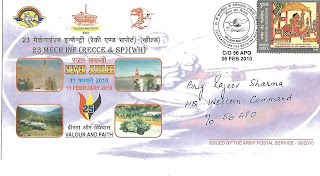On Post Card for prisoners in Italy
The letters, post cards and philately items presented here tell two stories. First, they are a testament to the arduous yet awe-inspiring journey of a soldier, Second Lieutenant (2nd Lt) J.C. Sharma, whose story lives on through his successors, including me, who followed in his footprints and dedicated their lives to their country, India and its Army like his father Lt R N Sharma (my grandfather) who joined the Army during the World War I. Secondly, these rare documents dating back to the World War I and World War II not only serve as an invaluable connect with the important events from our past, but also are treasured family Mementoes.
Censored letter by Captain RM Sharma, father of 2nd Lt J C Sharma, (my grandfather), dated 24 February 1919, from base office.
On 16 June 1942, he along with many others from his unit 1/6 Rajputana Rifles, were taken as POWs,
On 16th and 18th June 1942, the family received information by signals of the Controller of Military Accounts & Pensions and the Adjutant General's branch.
Signal from Controller of Military Accounts & Pensions, dated 10 August 1942, informing about him being taken POW on 16 June 1942
A Demi Official (DO) letter by the Commanding Officer of his unit was also received by our family.
A DO letter from the then Commanding Officer Lt Col I.R.West, dated 18 July 1942, informing our family about 2nd Lt Sharma being taken POW. Cover, On Active Service, passed by censor, round stamp No 1115 and FPO number 49 dated 20 July 1942 on the envelope.
On receiving the information of her son being taken as a POW, his mother fell sick and was serious
Telegram dated 14 September 1942, from mother of 2nd Lt JC Sharma (Savitri Pandit) addressed to her younger son Kuldip Sharma, asking him to reach Kud, in Jammu & Kashmir
In November 1942, the family received more information. The Italian authorities sent a Post Card for war prisoners, with double rim marked number 131 with DHP/5 marking with a censor stamp, intimating that he had indeed been taken as POW and was being transferred to a prisoner camp.
2nd Lt Sharma sent his family a censored post card from PG75 (3450) campo (field or military camp), having censor stamp and DHP/138 marking. The location of this PG75 (Prigioniero di Guerra, meaning ' prisoner of war') was in Torre Tresca, Bari, in southern Italy on the eastern coast, on the Adriatic Sea. He was later shifted to Campo PG63.
A censored letter from PG63, at Marinaro A versa near Arezzo, Province of Caserta, where most Indian POWs were kept, having DHP/9 censor stamp, marked DHP/114, with Per Aerea (by air) on top left corner. Interestingly, he was promoted to the rank of a lieutenant at this camp. The letter was addressed to his younger brother, motivating him to join the Army too. His brother too chose to follow his father and brother's lead and joined the Army. He was undergoing training as an officer cadet when this letter dated 28 July 1943, arrived. Later he joined too and fought during World War II in Burma.
Maj KC Sharma, later served in the Infantry School Mhow in 1953.
Extracts of the Book which recapitulates 1/6 Rajputana Rifles troops during the battle of Tobruk.
In 1943, he escaped from the PG63 POW camp and found his way back home. All his family ever got to know was that it took him a few months as he was trained not to divulge any details of his escape.
My Unit First Day Cover, with round stamp of 56 Army Post Office, addressed to Brigadier Rajeev Sharma, that is me, now Major General Rajeev Sharma (Retired) of the Indian Army.

































































